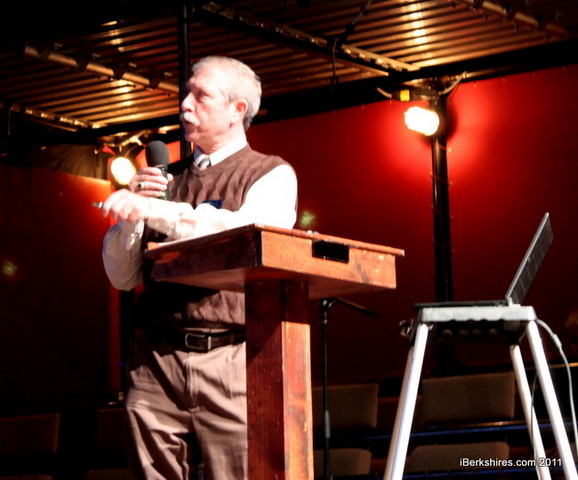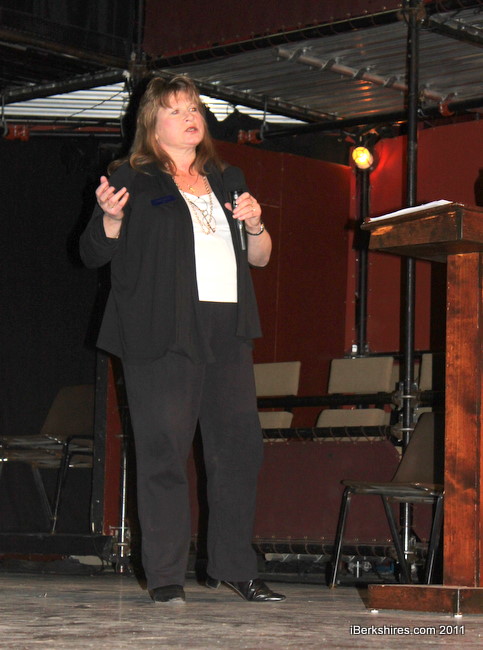
EPA Talks River Cleanup Options
LENOX, Mass. — Restoring the Housatonic River is critical to growing the region's "green capital" but it has to be done right the first time, say federal officials."The challenge of restoring the river is restoring green capital to this area," Curt Spalding, regional administrator for the U.S. Environmental Protection Agency, told those gathered Thursday night in Founders' Theatre at Shakespeare & Company. "With the industrialization of this region we lost a lot. The rivers, not just this river, were contaminated, the land was contaminated. We need to build prosperity for the 21st century and beyond.
"The economy is built on the environment in New England. We're all here because something pretty tragic happened in the Berkshires. This is our opportunity. We're not going to get two bites of this apple, we're going to get one."
More than 40 people, including environmentalists, sportsmen and concerned residents attended Thursday's session, the last of three mini-workshops on the history of the river, the health effects of the polychlorinated biphynels dumped into the river for decades by GE, and alternatives for cleanup, remediation and restoration of 10 miles of the river south of Pittsfield to Connecticut.
Michael Palermo of Mike Palermo Consultating Inc. of Durham, N.C., a dredging and remediation engineer, said there are several options for cleanup and the pros and cons of each weigh heavy on the EPA's final decision. Palermo outlined three methods — monitored natural recovery, in-situ capping and environmental dredging.
While he did not indicate which he thought would be the most feasible for the Housatonic, Palermo did address the advantages and disadvantages of each.
 Susan Svirsky, EPA project manager, said the cleanup had to leave the 'smallest footprint possible.' |
"[Monitored natural recovery] does not mean no action is taken," he said. "It does involve looking at the natural processes of reducing the risk over time. The process is slow and the risk is that it takes time to reduce that environmental risk. Capping is isolating the contaminated sediment with a layer of clay material. The advantages of this are that it's cost- effective, it's quick and it has the potential for enhancement. Some of the disadvantages are that contaminated sediments remain to a certain extent, water depths can be significantly reduced and long term monitoring and maintenance is required."
Palermo said both methods are very involved but none so much as the dredging and disposal process, which many residents and river activist groups believe is the best and only method to successfully rid the river of most of the PCBs. GE, which will foot the bill for a project that could cost in hundreds of millions, is promoting the less aggressive method.
"There are two different kinds of dredging, navigational dredging and environmental dredging. The real advantage of dredging is that you do remove the contaminated material, it is proven technology and it's easily implemented," said Palermo. "Of course, it still leaves residual material and it's expensive. There's no magic dredge. You still have to get rid of that stuff after you dredge it."
The cleanup method, especially capping or dredging, will also determine the restoration process. Keith Bowers, president and founder of Biohabitats Inc., a South Carolina-based firm specializing in environmental restoration, said successful restoration requires planning, a lot of planning.
"Restoration is an active process that happens over time," he said. "It's an accelerated recovery but it has to happen along an intended trajectory. It's not about going back in time, it's about restoring the future habitat. It is impossible to recapture that landscape in a previous time. We need to be adaptive in the way that we design, plan, implement and manage restoration projects."
In addition to explicit plans, schedules and sound science, the river cleanup, said Susan Svirsky, EPA project manager for "Rest of River," will require common sense and a "surgical mindset."
"We have cultural resources in this area that we need to be concerned about," she said. "This cannot be done in a vacuum. We need to consider the quality of life of the people who live on the river during the remediation process. These PCBs are a real risk to human health and a harm to animals in the river and those in the flood plains. We need to approach this like a surgeon would. I've had two knee replacements and I didn't want him to go in with a Sawzall when he can use a laser. We need to leave the smallest footprint possible."















